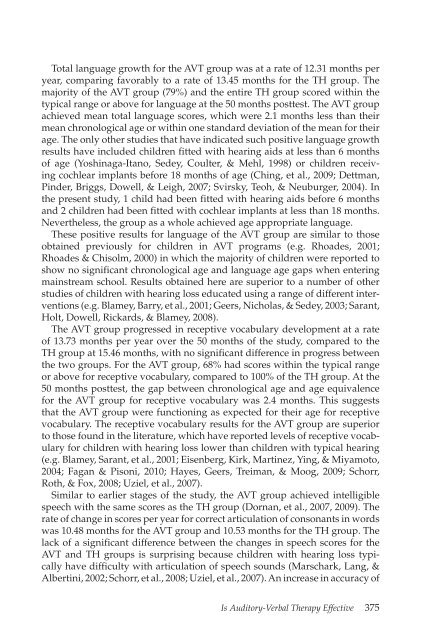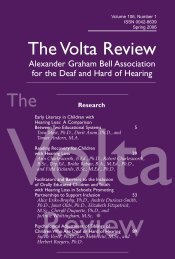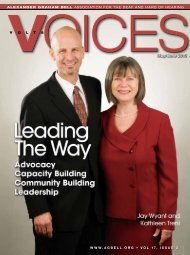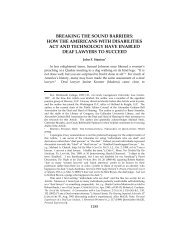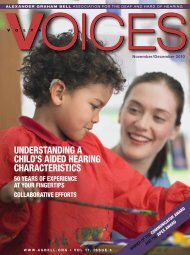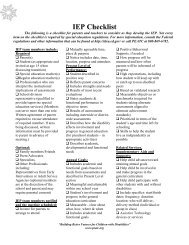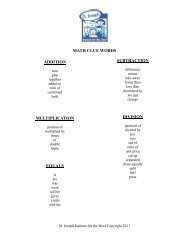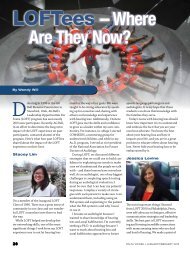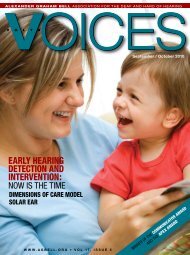Download this issue - Alexander Graham Bell Association
Download this issue - Alexander Graham Bell Association
Download this issue - Alexander Graham Bell Association
You also want an ePaper? Increase the reach of your titles
YUMPU automatically turns print PDFs into web optimized ePapers that Google loves.
Total language growth for the AVT group was at a rate of 12.31 months per<br />
year, comparing favorably to a rate of 13.45 months for the TH group. The<br />
majority of the AVT group (79%) and the entire TH group scored within the<br />
typical range or above for language at the 50 months posttest. The AVT group<br />
achieved mean total language scores, which were 2.1 months less than their<br />
mean chronological age or within one standard deviation of the mean for their<br />
age. The only other studies that have indicated such positive language growth<br />
results have included children fitted with hearing aids at less than 6 months<br />
of age (Yoshinaga-Itano, Sedey, Coulter, & Mehl, 1998) or children receiving<br />
cochlear implants before 18 months of age (Ching, et al., 2009; Dettman,<br />
Pinder, Briggs, Dowell, & Leigh, 2007; Svirsky, Teoh, & Neuburger, 2004). In<br />
the present study, 1 child had been fitted with hearing aids before 6 months<br />
and 2 children had been fitted with cochlear implants at less than 18 months.<br />
Nevertheless, the group as a whole achieved age appropriate language.<br />
These positive results for language of the AVT group are similar to those<br />
obtained previously for children in AVT programs (e.g. Rhoades, 2001;<br />
Rhoades & Chisolm, 2000) in which the majority of children were reported to<br />
show no significant chronological age and language age gaps when entering<br />
mainstream school. Results obtained here are superior to a number of other<br />
studies of children with hearing loss educated using a range of different interventions<br />
(e.g. Blamey, Barry, et al., 2001; Geers, Nicholas, & Sedey, 2003; Sarant,<br />
Holt, Dowell, Rickards, & Blamey, 2008).<br />
The AVT group progressed in receptive vocabulary development at a rate<br />
of 13.73 months per year over the 50 months of the study, compared to the<br />
TH group at 15.46 months, with no significant difference in progress between<br />
the two groups. For the AVT group, 68% had scores within the typical range<br />
or above for receptive vocabulary, compared to 100% of the TH group. At the<br />
50 months posttest, the gap between chronological age and age equivalence<br />
for the AVT group for receptive vocabulary was 2.4 months. This suggests<br />
that the AVT group were functioning as expected for their age for receptive<br />
vocabulary. The receptive vocabulary results for the AVT group are superior<br />
to those found in the literature, which have reported levels of receptive vocabulary<br />
for children with hearing loss lower than children with typical hearing<br />
(e.g. Blamey, Sarant, et al., 2001; Eisenberg, Kirk, Martinez, Ying, & Miyamoto,<br />
2004; Fagan & Pisoni, 2010; Hayes, Geers, Treiman, & Moog, 2009; Schorr,<br />
Roth, & Fox, 2008; Uziel, et al., 2007).<br />
Similar to earlier stages of the study, the AVT group achieved intelligible<br />
speech with the same scores as the TH group (Dornan, et al., 2007, 2009). The<br />
rate of change in scores per year for correct articulation of consonants in words<br />
was 10.48 months for the AVT group and 10.53 months for the TH group. The<br />
lack of a significant difference between the changes in speech scores for the<br />
AVT and TH groups is surprising because children with hearing loss typically<br />
have difficulty with articulation of speech sounds (Marschark, Lang, &<br />
Albertini, 2002; Schorr, et al., 2008; Uziel, et al., 2007). An increase in accuracy of<br />
Is Auditory-Verbal Therapy Effective 375


